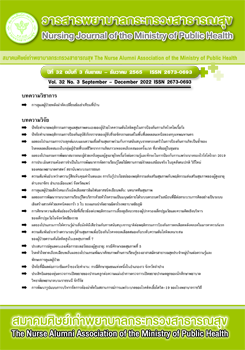The Effect of the Application of the Health Belief Model and Family Support Program on Recurrence Stroke Prevention among First Episode Stroke Survivors Dwelling in a Rural Community
Main Article Content
Abstract
This quasi-experimental study using a two-group pretest–posttest design aimed to evaluate the effects of using the Health Belief Model and the family supporting program on the recurrence of stroke prevention among first episode stroke survivors. The sample consisted of 60 first episode stroke survivors. They were randomly divided into an experimental group (n=30) and a comparison group (n=30). The study took a total of 8 weeks. The experimental group was provided with information to enhance their perceived severity, perceived benefit, perceived barrier, perceived susceptibility, and family support. The data was collected by using questionnaires during the pre-post experiment and follow-up stage, and analyzed using descriptive statistics Chi-square, repeated measures ANOVA, and independent t-tests. After the intervention, the results found that the experimental group had a significantly better mean score for recurrent stroke preventive behavior in terms of eating behavior, medication adherence behavior, adherence to doctor appointments, exercise behavior and observing the warning signs of recurrence stroke, than pre-experimental group and better than the comparison group (p<.05). The research findings can be used as healthcare guidelines for survivors of first episode stroke reduce the likelihood of recurrent strokes. In addition, they can be used to guide healthcare for patients with
Article Details

This work is licensed under a Creative Commons Attribution-NonCommercial-NoDerivatives 4.0 International License.
บทความและรายงานวิจัยในวารสารพยาบาลกระทรวงสาธารณสุข เป็นความคิดเห็นของ ผู้เขียน มิใช่ของคณะผู้จัดทำ และมิใช่ความรับผิดชอบของสมาคมศิษย์เก่าพยาบาลกระทรวงสาธารณสุข ซึ่งสามารถนำไปอ้างอิงได้
References
World Stroke Organization. World stroke campaign [Internet].2017 [cited 2020 December 16]. Available from: https://www.world-stroke.org/world-stroke-day-campaign
National Stroke Association. Recovery after stroke [Internet].2017 [cited 2020 December 20]. Available from: http://www.stroke.org/
Bureau of Policy and Strategy, Ministry of Public Health [Internet]. Public health statistic.2017 [cited 2020 December 11]. Available from: http://dmsic.moph.go.th/index/detail/7892.(in Thai)
Sereewichayasawad N, Maneewong P, Srisuk O, Phongern N, Neilpaijit N. Factors related to hospital readmission among stroke patient in home health care unit. Journal of Public Health Nursing 2016;28(3):30-40.(In Thai)
Tepsuwan J. Recurrent prevention for stroke survivors. Proceedings of the 1th NPRU National Academic Conference. Nakhon Pathom: Silpakorn University;2018.(In Thai)
World Health Organization. The WHO STEP wise approach to stroke surveillance [Internet].2017 [cited 2020 December 16]. Available from: http://www.who.int/ncd_suveillance/en/step stroke_mannual_vl.2.pdf
Mendis S. Stroke disability and rehabilitation of stroke: World Health Organization perspective. International Journal of Stroke 2013;8(1):3-4.
Tiamkao S. Recurrent ischemic stroke in Srinagarind hospital. North-Eastern Thai Journal of Neuroscience 2011; 6(3):31-8.(In Thai)
Khumsa-ard S, Thiangtham W, Boonyamalik P. Behavior factors related to recurrent stroke. Journal of Public Health Nursing 2017;31(2):13-25.(in Thai)
Kernan WN, Ovbiagele B, Black HR, Bravata DM, Chimowitz MI, Ezekowitz MD, et al. Guidelines for the prevention of stroke in patients with stroke and transient ischemic attack: a guideline for healthcare professionals from the American Heart Association/American Stroke Association. Stroke 2014;45(7):2160-236.
Skinner CS, Tiro J, Champion VL. The health belief model. health behavior: theory, research, and practice, 5th ed. Hoboken, NJ, US: Jossey-Bass/Wiley;2015:75-94.
Powwattana A, Kalampakorn S,Lagampan S, Rawiworrakul T. Health promotion and disease prevention in community: An application of concepts and theories to practice. Bangkok: m n compute offset;2018.(in Thai)
Witee T, Thiangtham W, Boonyamalik P. The recurrent stroke prevention behavior program in post stroke patients. Kuakarun Journal of Nursing 2021;28:7-19.(in Thai)
Khiawkhwao P, Thiangtham W, Boonyamalik P. The effects of the cerebral vascular disease prevention program in high risk group patients. Journal of Health and Nursing Research 2019;35(3):120-32.(in Thai)
Thiangtham W, Kalampakorn S, Powwattana A.Community capacity building : concept and applications.4th ed. Bangkok: Danex Intercorporation;2015.(in Thai)
Strecher VJ, Rosenstock IM. The health belief model end health behavior and health education—theory, research and practice.4th ed. the United States of America: Jossey-Bass;1996.
House J. Work stress and social support. reading, MA: Addison-Wesley;1981.
Srisatidnarakul B. Effect size power analysis optimal sample size calculations using G*Power Software. Bangkok: Chula press;2020.(in Thai)
Prasat Neurological Institute, Ministry of Public Health. Stroke clinical practice guideline for nursing. Bangkok: Thana Place;2015.(in Thai)

